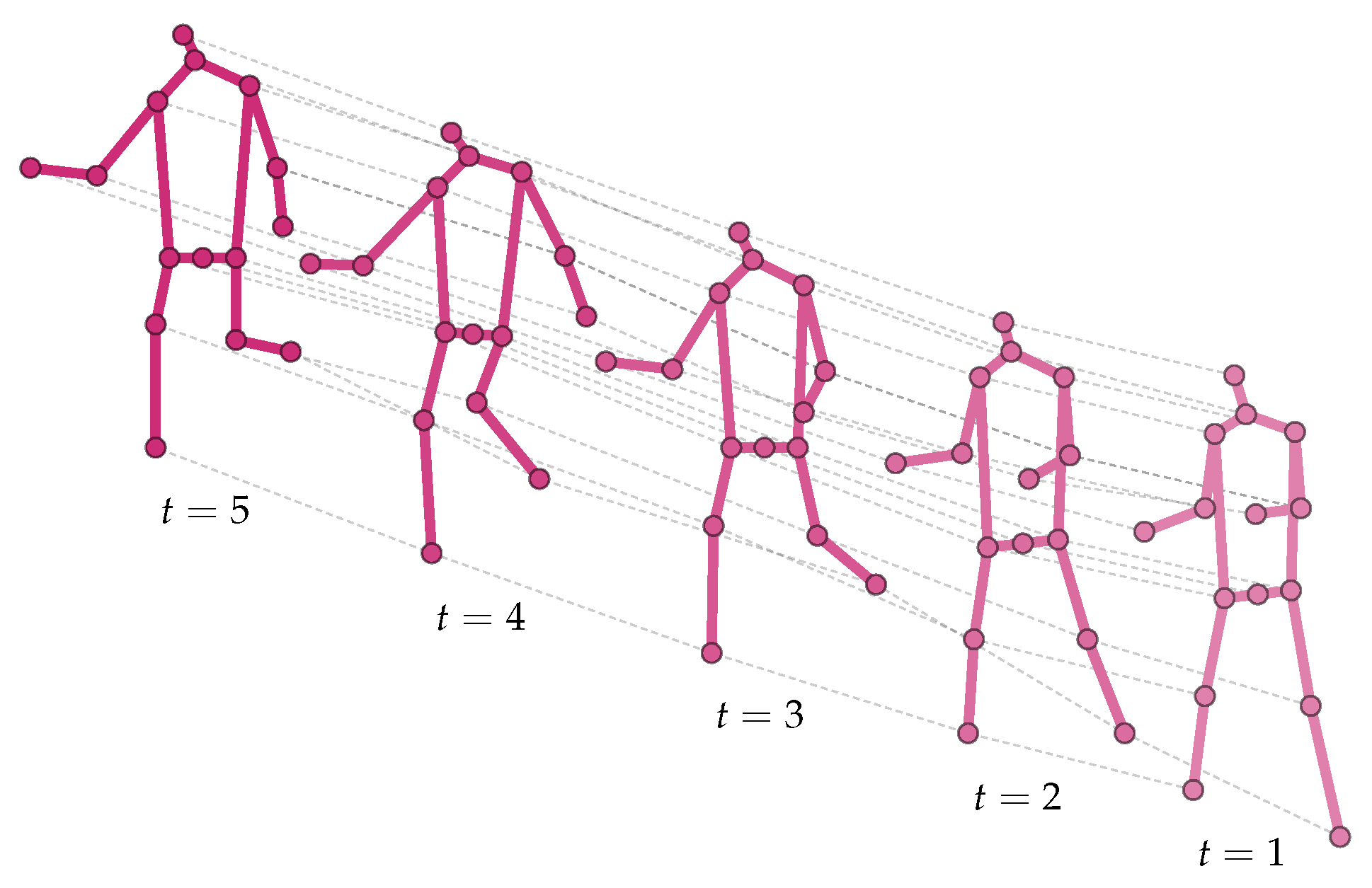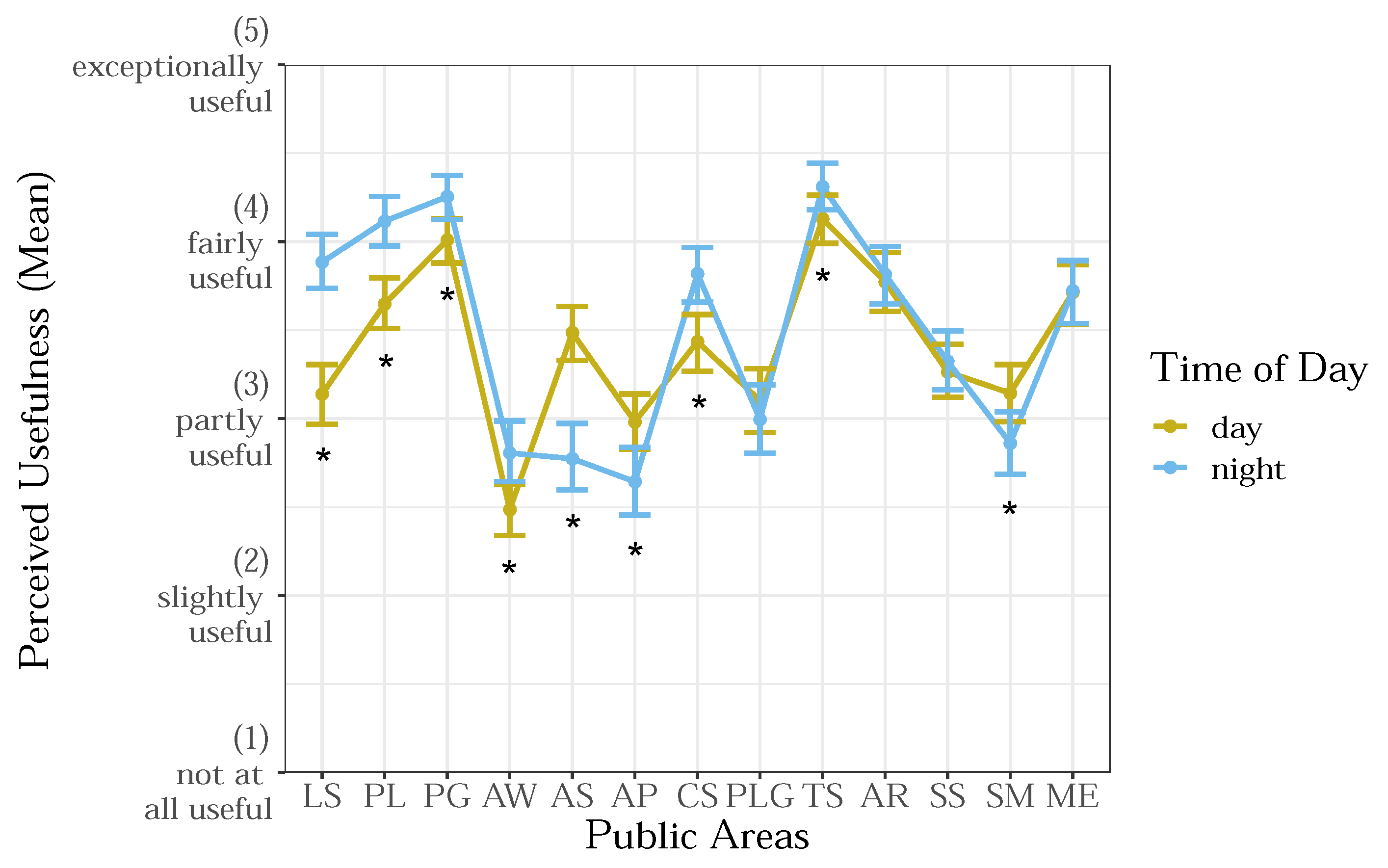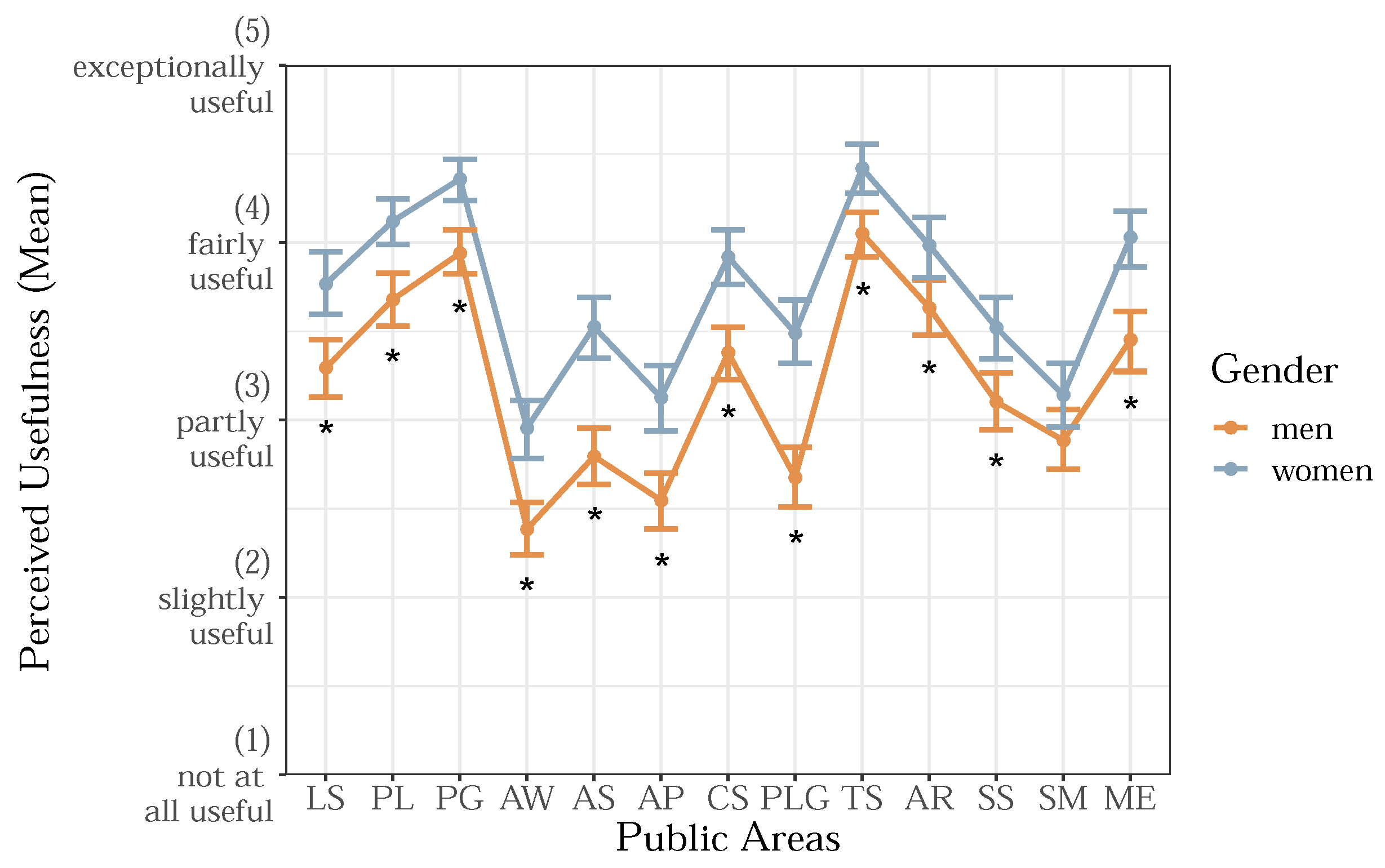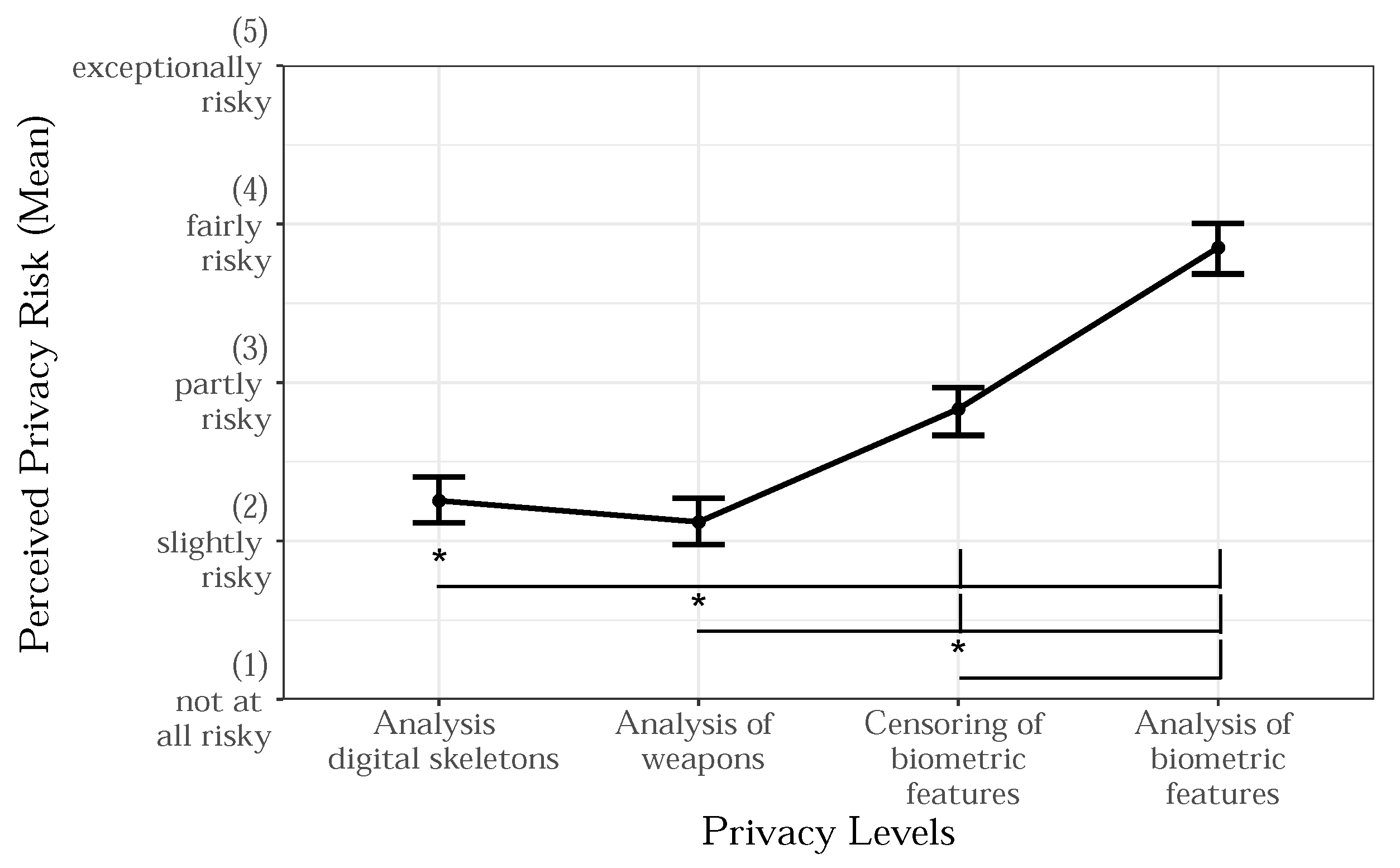Perception of Risks and Usefulness of Smart Video Surveillance Systems
Abstract
1. Introduction
1.1. Smart Video Surveillance Using Digital Skeletons
1.2. Technical Principles of the Smart Subsystem
1.3. Acceptance Model
1.4. Perceived Usefulness
1.5. Perceived Privacy Risk
1.6. Aim of the Study
2. Method
2.1. Participants
2.2. Materials and Procedure
2.3. Statistical Analyses
3. Results
3.1. Perceived Usefulness
3.2. Perceived Privacy Risk
4. Discussion
Limitations
5. Conclusions
Author Contributions
Funding
Institutional Review Board Statement
Informed Consent Statement
Data Availability Statement
Conflicts of Interest
References
- Comparitech. Surveillance Camera Statistics: Which Cities Have the Most CCTV Cameras? Available online: https://www.comparitech.com/vpn-privacy/the-worlds-most-surveilled-cities/ (accessed on 23 May 2022).
- Golda, T. Image-based Anomaly Detection within Crowds. In Proceedings of the 2018 Joint Workshop of Fraunhofer IOSB and Institute for Anthropomatics, Vision and Fusion Laboratory; Beyerer, J., Taphanel, M., Eds.; Karlsruher Schriften zur Anthropomatik/Lehrstuhl für Interaktive Echtzeitsysteme, Karlsruher Institut für Technologie; Fraunhofer-Inst. für Optronik, Systemtechnik und Bildauswertung IOSB Karlsruhe; KIT Scientific Publishing: Karlsruhe, Germany, 2019; Volume 40, pp. 11–24. [Google Scholar]
- Weirauch, B. Stellungnahme des Minesteriums für Inneres, Digitalisierung und Migration. Einjährige Bilanz zur Novellierung des Polizeigesetzes Baden-Württemberg. Drucksache 16 / 8128 [Statement of the Ministry for Internal Affairs, Digitization and Migration. Annual Balance on the Amendment of the Police Law in Baden-Württemberg. document 16 / 8128]. Available online: https://www.landtag-bw.de/files/live/sites/LTBW/files/dokumente/WP16/Drucksachen/8000/16_8128\_D.pdf (accessed on 23 January 2022).
- Commission, T.E. Migration and Home Affairs. Responding to Terror Attacks. Available online: https://ec.europa.eu/home-affairs/pages/page/responding-terror-attacks_en (accessed on 23 January 2022).
- Roose, J. Wenn es Nacht wird in Deutschland. Ergebnisse einer repräsentativen Umfrage zu Kriminalitätsangst und der Akzeptanz von Maßnahmen gegen Kriminalität [When night falls in germany. Results from a representative Survey on Fear of Crime and the Acceptance of Actions against Crime]. Monitor Sicherheit, 25 October 2021. [Google Scholar]
- Krempel, E.L. Steigerung der Akzeptanz von Intelligenter Videoüberwachung in öffentlichen Räumen [Augmentation of Acceptance of Intelligent Video Surveillance in Public Spaces]; KIT Scientific Publishing: Karlsruhe, Germany, 2017; Volume 28. [Google Scholar]
- Hempel, L.; Toepfer, E. On the Threshold to Urban Panopticon? Cities and Assessing its Social and Political Impacts. Cctv in European Cities and Assessing Its Social and Political Impacts; Working Paper no. 15; TU Berlin Centre for Technology and Society Technical: Berlin, Germany, 2004. [Google Scholar]
- Senior, A.; Pankanti, S.; Hampapur, A.; Brown, L.; Tian, Y.L.; Ekin, A.; Connell, J.; Shu, C.F.; Lu, M. Enabling Video Privacy through Computer Vision. IEEE Secur. Priv. 2005, 3, 50–57. [Google Scholar] [CrossRef]
- Birnstill, P.; Ren, D.; Beyerer, J. A user study on anonymization techniques for smart video surveillance. In Proceedings of the 12th International Conference on Advanced Video and Signal Based Surveillance (AVSS), Karlsruhe, Germany, 25–28 August 2015; IEEE: Piscataway, NJ, USA, 2015; pp. 1–6. [Google Scholar] [CrossRef]
- Fraunhofer IOSB. Intelligent Video Surveillance Enhances Safety and Privacy. Available online: https://www.iosb.fraunhofer.de/en/projects-and-products/intelligent-video-surveillance.html (accessed on 5 October 2022).
- Senior, A.; Pankanti, S.; Hampapur, A.; Brown, L.; Tian, Y.L.; Ekin, A.; Connell, J.; Shu, C.F.; Lu, M. Blinkering Surveillance: Enabling Video Privacy through Computer Vision; Technical Report; IBM: Armonk, NY, USA, 2003. [Google Scholar]
- Markovitz, A.; Sharir, G.; Friedman, I.; Zelnik-Manor, L.; Avidan, S. Graph Embedded Pose Clustering for Anomaly Detection. In Proceedings of the 2020 IEEE/CVF Conference on Computer Vision and Pattern Recognition (CVPR), Seattle, WA, USA, 13–19 June 2020; pp. 10536–10544. [Google Scholar] [CrossRef]
- Morais, R.; Le, V.; Tran, T.; Saha, B.; Mansour, M.; Venkatesh, S. Learning Regularity in Skeleton Trajectories for Anomaly Detection in Videos. In Proceedings of the 2019 IEEE/CVF Conference on Computer Vision and Pattern Recognition (CVPR), Long Beach, CA, USA, 15–20 June 2019; pp. 11988–11996. [Google Scholar] [CrossRef]
- Krempel, E.; Beyerer, J. TAM-VS: A Technology Acceptance Model for Video Surveillance. In Privacy Technologies and Policy, Proceedings of the Second Annual Privacy Forum, APF 2014, Athens, Greece, 20–21 May 2014; Preneel, B., Ikonomou, D., Eds.; Springer: Cham, Switzerland, 2014. [Google Scholar] [CrossRef]
- Qi, Y.; Qin, L.; Zhang, S.; Huang, Q.; Yao, H. Robust visual tracking via scale-and-state-awareness. Neurocomputing 2019, 329, 75–85. [Google Scholar] [CrossRef]
- Yu, H.; Li, G.; Zhang, W.; Huang, Q.; Du, D.; Tian, Q.; Sebe, N. The unmanned aerial vehicle benchmark: Object detection, tracking and baseline. Int. J. Comput. Vis. 2020, 128, 1141–1159. [Google Scholar] [CrossRef]
- Wen, L.; Du, D.; Zhu, P.; Hu, Q.; Wang, Q.; Bo, L.; Lyu, S. Detection, tracking, and counting meets drones in crowds: A benchmark. In Proceedings of the 2021 IEEE/CVF Conference on Computer Vision and Pattern Recognition (CVPR), Nashville, TN, USA, 20–25 June 2021; IEEE: Piscataway, NJ, USA, 2021. [Google Scholar]
- Qi, Y.; Wu, Q.; Anderson, P.; Wang, X.; Wang, W.Y.; Shen, C.; van den Hengel, A. REVERIE: Remote embodied visual referring expression in real indoor environments. In Proceedings of the 2020 IEEE/CVF Conference on Computer Vision and Pattern Recognition (CVPR), Seattle, WA, USA, 13–19 June 2020; IEEE: Piscataway, NJ, USA, 2020. [Google Scholar]
- Qi, Y.; Zhang, S.; Jiang, F.; Zhou, H.; Tao, D.; Li, X. Siamese local and global networks for robust face tracking. IEEE Trans. Image Process. 2020, 29, 9152–9164. [Google Scholar] [CrossRef] [PubMed]
- Meng, Q.; Zhao, S.; Huang, Z.; Zhou, F. MagFace: A universal representation for face recognition and quality assessment. In Proceedings of the 2021 IEEE/CVF Conference on Computer Vision and Pattern Recognition (CVPR), Nashville, TN, USA, 20–25 June 2021; IEEE: Piscataway, NJ, USA, 2021. [Google Scholar]
- Specker, A.; Schumann, A.; Beyerer, J. An evaluation of design choices for pedestrian attribute recognition in video. In Proceedings of the 2020 IEEE International Conference on Image Processing (ICIP), Abu Dhabi, United Arab Emirates, 25–28 October 2020; IEEE: Piscataway, NJ, USA, 2020. [Google Scholar]
- Specker, A.; Stadler, D.; Florin, L.; Beyerer, J. An occlusion-aware multi-target multi-camera tracking system. In Proceedings of the 2021 IEEE/CVF Conference on Computer Vision and Pattern Recognition Workshops (CVPRW), Virtual Conference, 19–25 June 2021; IEEE: Piscataway, NJ, USA, 2021. [Google Scholar]
- Jiang, S.; Qi, Y.; Zhang, H.; Bai, Z.; Lu, X.; Wang, P. D3D: Dual 3-D Convolutional Network for Real-Time Action Recognition. IEEE Trans. Industr. Inform. 2021, 17, 4584–4593. [Google Scholar] [CrossRef]
- Yang, F.; Wu, Y.; Sakti, S.; Nakamura, S. Make skeleton-based action recognition model smaller, faster and better. In Proceedings of the ACM Multimedia Asia; ACM: New York, NY, USA, 2019. [Google Scholar]
- European Commission. Regulation (EU) 2016/679 of the European Parliament and of the Council of 27 April 2016 on the Protection of Natural Persons with Regard to the Processing of Personal Data and on the Free Movement of Such Data, and Repealing Directive 95/46/EC (General Data Protection Regulation) (Text with EEA Relevance). 2016. Available online: https://eur-lex.europa.eu/eli/reg/2016/679/oj (accessed on 5 October 2022).
- European Commission. Commission Implementing Regulation (EU) 2019/947 of 24 May 2019 on the Rules and Procedures for the Operation of Unmanned Aircraft (Text with EEA Relevance.). 2019. Available online: https://eur-lex.europa.eu/legal-content/EN/TXT/?uri=CELEX%3A32019R0947 (accessed on 5 October 2022).
- Pūraitė, A.; Šilinskė, N. Privacy Protection in the New EU Regulations on the use of unmanned aerial systems. Public Secur. Public Order 2020, 24, 173–183. [Google Scholar]
- Kohl, P.; Specker, A.; Schumann, A.; Beyerer, J. The MTA dataset for multi target multi camera pedestrian tracking by weighted distance aggregation. In Proceedings of the 2020 IEEE/CVF Conference on Computer Vision and Pattern Recognition Workshops (CVPRW), Seattle, WA, USA, 14–19 June 2020; IEEE: Piscataway, NJ, USA, 2020. [Google Scholar]
- Golda, T.; Kalb, T.; Schumann, A.; Beyerer, J. Human pose estimation for real-world crowded scenarios. In Proceedings of the 2019 16th IEEE International Conference on Advanced Video and Signal Based Surveillance (AVSS), Taipei, Taiwan, 18–21 September 2019; IEEE: Piscataway, NJ, USA, 2019. [Google Scholar]
- Golda, T.; Blattmann, A.; Metzler, J.; Beyerer, J. Image domain adaption of simulated data for human pose estimation. In Proceedings of the Artificial Intelligence and Machine Learning in Defense Applications II; Dijk, J., Ed.; SPIE: Bellingham, WA, USA, 2020. [Google Scholar]
- Liu, C.; Fu, R.; Li, Y.; Gao, Y.; Shi, L.; Li, W. A Self-Attention Augmented Graph Convolutional Clustering Networks for Skeleton-Based Video Anomaly Behavior Detection. Appl. Sci. 2022, 12, 4. [Google Scholar] [CrossRef]
- Zeng, X.; Jiang, Y.; Ding, W.; Li, H.; Hao, Y.; Qiu, Z. A Hierarchical Spatio-Temporal Graph Convolutional Neural Network for Anomaly Detection in Videos. IEEE Trans. Circ. Syst. Video Technol. 2021, 1. [Google Scholar] [CrossRef]
- IOSB, F. Öffentliche Sicherheit: Innenminister Besucht Fraunhofer IOSB [Public Security: Minister for Inner Affairs Visits Fraunhofer IOSB]. Available online: https://www.iosb.fraunhofer.de/de/presse/presseinformationen/2018/privatsphaere-und-datenschutz.html (accessed on 13 October 2022).
- Golda, T. Part Affinity Field based Activity Recognition. In Proceedings of the 2019 Joint Workshop of Fraunhofer IOSB and Institute for Anthropomatics, Vision and Fusion Laboratory; Beyerer, J., Zander, T., Eds.; Karlsruher Schriften zur Anthropomatik/Lehrstuhl für Interaktive Echtzeitsysteme, Karlsruher Institut für Technologie; Fraunhofer-Inst. für Optronik, System und Bildauswertung IOSB Karlsruhe; KIT Scientific Publishing: Karlsruhe, Germany, 2020; Volume 45, pp. 53–65. [Google Scholar]
- Fang, H.S.; Xie, S.; Tai, Y.W.; Lu, C. RMPE: Regional Multi-person Pose Estimation. In Proceedings of the 2017 IEEE International Conference on Computer Vision (ICCV), Venice, Italy, 22–29 October 2017; pp. 2353–2362. [Google Scholar] [CrossRef]
- Iqbal, U.; Milan, A.; Gall, J. PoseTrack: Joint Multi-person Pose Estimation and Tracking. In Proceedings of the 2017 IEEE Conference on Computer Vision and Pattern Recognition (CVPR), Honolulu, HI, USA, 21–26 July 2017; pp. 4654–4663. [Google Scholar] [CrossRef]
- Munea, T.L.; Jembre, Y.Z.; Weldegebriel, H.T.; Chen, L.; Huang, C.; Yang, C. The Progress of Human Pose Estimation: A Survey and Taxonomy of Models Applied in 2D Human Pose Estimation. IEEE Access 2020, 8, 133330–133348. [Google Scholar] [CrossRef]
- Davis, F.D. Perceived usefulness, perceived ease of use, and user acceptance of information technology. MIS Q. 1989, 13, 319–340. [Google Scholar] [CrossRef]
- Spiekermann, S. User Control in Ubiquitous Computing: Design Alternatives and User Acceptance; Shaker Verlag: Herzogenrat, Germany, 2008. [Google Scholar]
- Golda, T.; Cormier, M.; Beyerer, J. Intelligente Bild- und Videoauswertung für die Sicherheit [Intelligent Image and Video Analysis for Security Applications]. In Handbuch Polizeimanagement: Polizeipolitik–Polizeiwissenschaft–Polizeipraxis; Wehe, D., Siller, H., Eds.; Springer Fachmedien: Wiesbaden, Germany, 2022; pp. 1–21. [Google Scholar] [CrossRef]
- Hoelscher, M. Sicherheitsgefühl und Überwachung. Eine empirische Studie zu Einstellungen der Bürger zur Videoüberwachung und ihrer Erklärung [Security Sense and Surveillance—An Empirical Study of Citizens’ Attitudes Toward Video Surveillance and its Explanation]. Kriminol. J. 2003, 35, 42–56. [Google Scholar]
- Klauser, F.R. Die Videoüberwachung öffentlicher Räume: Zur Ambivalenz eines Instruments Sozialer Kontrolle [Video Surveillance of Public Spaces: On the Ambivalence of an Instrument of Social Control]; Campus: Frankfurt am Main, Germany, 2006. [Google Scholar]
- Kudlacek, D. Akzeptanz von Videoüberwachung—Eine Sozialwissenschaftliche Untersuchung Technischer Sicherheitsmaßnahmen [Acceptance of Video Surveillance—A Social Scientific Investigation of Technical Security Measures]; Springer: Wiesbaden, Germany, 2015. [Google Scholar]
- Forster, M.; Huber, M.E.; Wüster, A. Subjektives Sicherheitsgefühl und Überwachung [Subjective sense of security and monitoring]. In Komfortsignatur mit der Health Professional Card; Donau Universität Krems: Krems, Austria, 2008. [Google Scholar]
- Bornewasser, M.; Kober, M. Videoüberwachung: Kriminalitätsreduzierung und gezielte Verdrängung. Bericht über eine Evaluationsmaßnahme in der Stadt Luxemburg [Video Surveillance: Crime Reduction and Targeted Displacement. Report on an Evaluation Measure in the City of Luxembourg]. Forum Kriminalprävention 2012, 2, 34–42. [Google Scholar]
- Bornewasser, M.; Schulz, F. Videoüberwachung öffentlicher Straßen und Plätze, Ergebnisse eines Pilotprojektes in Brandenburg. Ergebnisse der Evaluationsstudie im Land Brandenburg [Video Surveillance of Public Roads and Squares, Results of a Pilot Project in Brandenburg. Results of the Evaluation Study in the State of Brandenburg]; Bornewasser, M., Classen, C.D., Stolpe, I., Eds.; Verlag für Polizeiwissenschaft: Frankfurt am Main, Germany, 2008. [Google Scholar]
- Cavoukian, A. Privacy by Design. The 7 Foundational Principles: Implementation and Mapping of Fair Information Practices; Technical Report; Information and Privacy Commissioner of Ontario: Toronto, ON, Canada, 2009. [Google Scholar]
- el den Mohamed, M.K.; Taha, A.; Zayed, H.H. Automatic gun detection approach for video surveillance. Int. J. Sociotechnology Knowl. Dev. 2020, 12, 49–66. [Google Scholar] [CrossRef]
- Bretthauer, S. Intelligente Videoüberwachung: Eine datenschutzrechtliche Analyse unter Berücksichtigung technischer Schutzmaßnahmen [Intelligent Video Surveillance: A Data Protection Analysis Considering Technical Protection Measures]; Nomos: Grassshut, Germany, 2017; Volume 50. [Google Scholar]
- Franke, T.; Attig, C.; Wessel, D. A Personal Resource for Technology Interaction: Development and Validation of the Affinity for Technology Interaction (ATI) Scale. Int. J. Hum.–Comput. Interact. 2019, 35, 456–467. [Google Scholar] [CrossRef]





| (AP) Amusement Parks | (LE) Large Events | (SM) Shopping Malls |
| (AR) Airports | (LS) Low-Traffic Sidewalks | (SS) Shopping Streets |
| (AS) Areas Surrounding Schools | (PG) Parking Garages | (TS) Train Stations |
| (AW) Areas Surrounding Workplace | (PL) Parking Lots | |
| (CS) City Squares | (PLG) Playgrounds |
| F | p | ||||
|---|---|---|---|---|---|
| Public area × time of day | 47.03 | 7.79 | 1666.25 | ≤0.0001 | 0.180 |
| Public area × gender | 2.67 | 12 | 2568 | 0.001 | 0.012 |
| Public area | 110.83 | 7.63 | 1631.83 | ≤0.0001 | 0.341 |
| Time of day | 5.73 | 1 | 214 | 0.018 | 0.026 |
| Gender | 18.46 | 1 | 214 | ≤0.0001 | 0.079 |
| PL | PG | AW | AS | AP | CS | PLG | TS | AR | SS | SM | ME | |
| LS | 3 | 3 | 3 | 3 | 1 | 2 | 2 | 3 | 3 | 2 | 1 | |
| PL | 3 | 3 | 2 | 2 | 3 | 3 | 3 | 2 | 3 | 3 | 2 | |
| PG | 3 | 3 | 3 | 3 | 3 | 3 | 3 | 3 | ||||
| AW | 1 | 3 | 1 | 1 | 3 | 3 | 3 | 1 | 3 | |||
| AS | 2 | 1 | 1 | 3 | 2 | 2 | 1 | 2 | ||||
| AP | 3 | 3 | 3 | 3 | 3 | 1 | ||||||
| CS | 2 | 3 | 3 | 3 | 3 | |||||||
| PLG | 3 | 3 | 2 | 3 | ||||||||
| TS | 3 | 3 | 3 | 3 | ||||||||
| AR | 3 | 3 | ||||||||||
| SS | 2 | 3 | ||||||||||
| SM | 3 |
| PL | PG | AW | AS | AP | CS | PLG | TS | AR | SS | SM | ME | |
| LS | 3 | 3 | 3 | 1 | 3 | 1 | 3 | 3 | ||||
| PL | 3 | 3 | 3 | 1 | 3 | 3 | 3 | 3 | 3 | |||
| PG | 3 | 3 | 3 | 3 | 3 | 2 | 3 | 3 | ||||
| AW | 3 | 2 | 2 | 3 | 3 | 3 | 1 | 3 | ||||
| AS | 3 | 2 | 3 | 3 | 1 | 2 | 3 | |||||
| AP | 3 | 3 | 3 | 3 | ||||||||
| CS | 2 | 3 | 3 | 3 | 1 | 3 | ||||||
| PLG | 3 | 3 | 1 | 2 | 3 | |||||||
| TS | 3 | 3 | 3 | 3 | ||||||||
| AR | 3 | 3 | ||||||||||
| SS | 3 | 3 | ||||||||||
| SM | 3 |
Publisher’s Note: MDPI stays neutral with regard to jurisdictional claims in published maps and institutional affiliations. |
© 2022 by the authors. Licensee MDPI, Basel, Switzerland. This article is an open access article distributed under the terms and conditions of the Creative Commons Attribution (CC BY) license (https://creativecommons.org/licenses/by/4.0/).
Share and Cite
Golda, T.; Guaia, D.; Wagner-Hartl, V. Perception of Risks and Usefulness of Smart Video Surveillance Systems. Appl. Sci. 2022, 12, 10435. https://doi.org/10.3390/app122010435
Golda T, Guaia D, Wagner-Hartl V. Perception of Risks and Usefulness of Smart Video Surveillance Systems. Applied Sciences. 2022; 12(20):10435. https://doi.org/10.3390/app122010435
Chicago/Turabian StyleGolda, Thomas, Deborah Guaia, and Verena Wagner-Hartl. 2022. "Perception of Risks and Usefulness of Smart Video Surveillance Systems" Applied Sciences 12, no. 20: 10435. https://doi.org/10.3390/app122010435
APA StyleGolda, T., Guaia, D., & Wagner-Hartl, V. (2022). Perception of Risks and Usefulness of Smart Video Surveillance Systems. Applied Sciences, 12(20), 10435. https://doi.org/10.3390/app122010435








